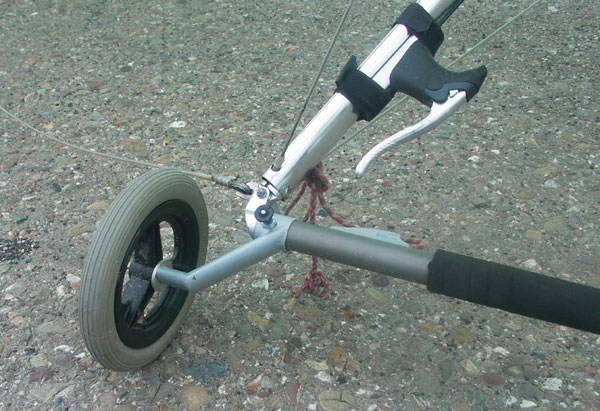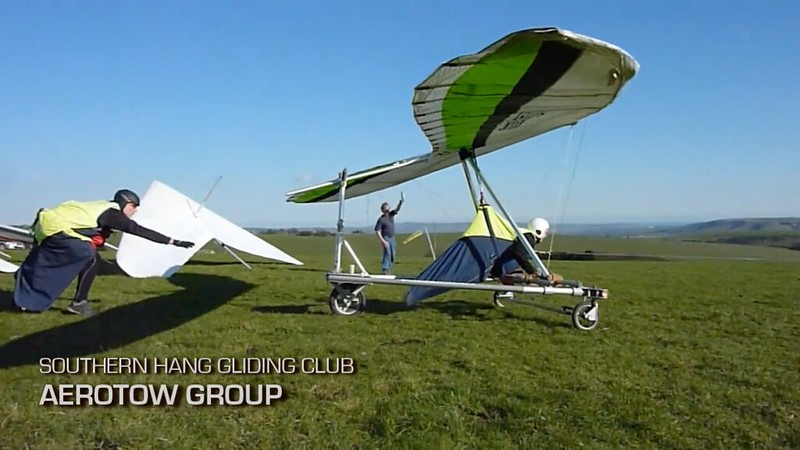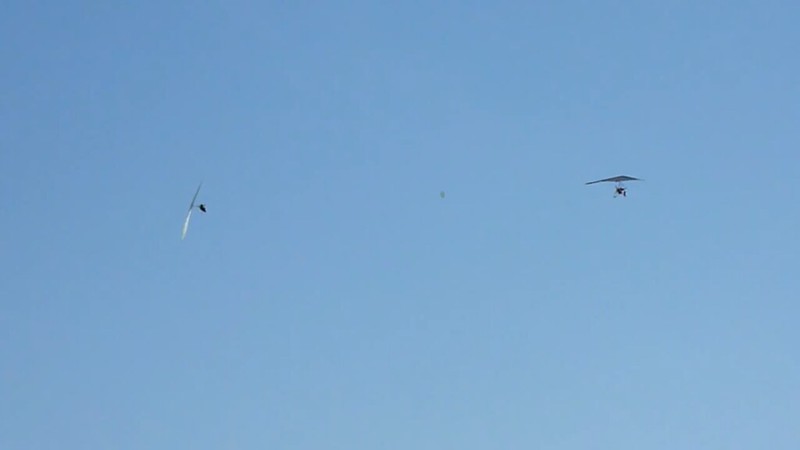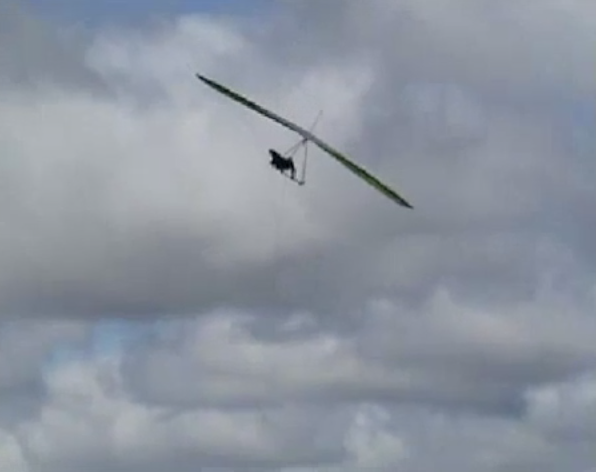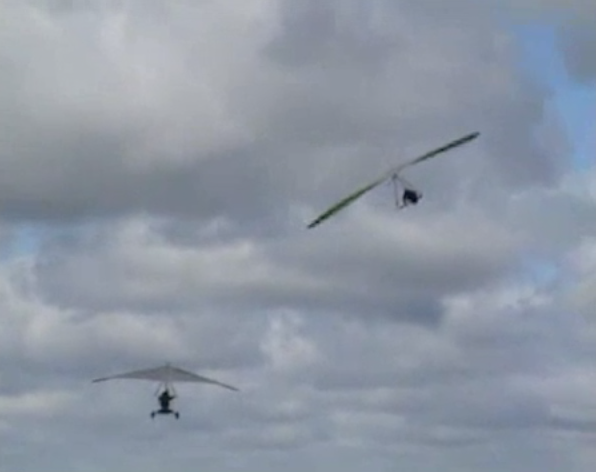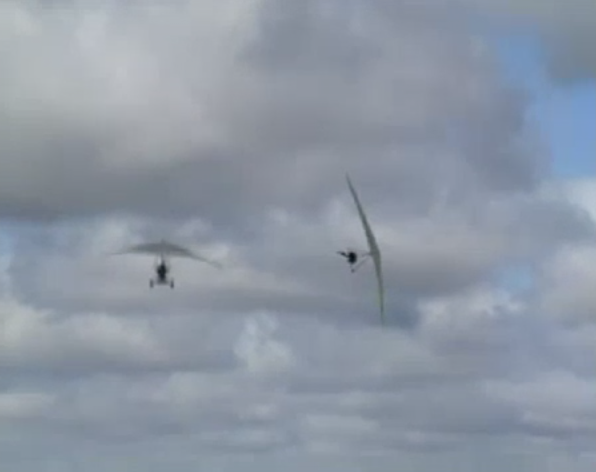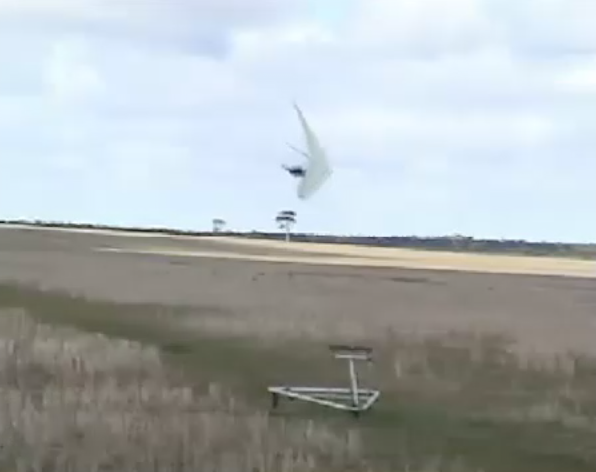http://ozreport.com/9.179
Fatality Report
Angelo Mantas - 2005/08/30
Scenario - Mike Haas's accident happened during midday thermal conditions. He was flying a Moyes 147 Litesport, aerotowing it off of a launch dolly. Several witnesses saw the accident, but I give Dave Whedon's account the most weight, because a) He saw the entire event, from start to finish, and b) He was watching several tows intently to see what conditions were like, since he hadn't towed in a while.
The tug was given the "go" signal. Dave said that almost as soon as Mike launched off the cart, he appeared to be having difficulty with both pitch and roll control. Then, at around fifty to sixty feet, the glider pitched up radically and started arcing to the left. Somewhere around this time the weak link broke, or the pilot released. The glider continued rotating left and dove into the ground, first hitting the left wing tip, then nose. The glider's pitch was near vertical on impact, confirmed by the fact that the control bar, except for a bend in one downtube, was basically intact, whereas the keel and one leading edge snapped just behind the nose plate junction. This all happened fairly quickly. Based on witness and tug pilot accounts, the glider was never over a hundred feet.
Despite help reaching him almost instantly, attempts to revive him proved futile. Mike suffered a broken spinal cord and was probably killed instantly.
Causes
In examining the circumstances surrounding the accident, it seems to me that several factors, which by themselves might not cause major problems, combined to lead to Mike's losing control of the glider.
1) New, high performance glider.
2) Larger size glider than what he was used to.
3) A fast flying tug (Kolb)
4) Flying through a thermal just after launching.
5) A rearward keel attachment point on the "V" bridle.
Mike had only one previous flight on his new Litesport, in laminar coastal ridge soaring conditions. Although he flew over two hours, he probably never flew the glider at the speeds encountered when aerotowing. Mike had many aerotows on a Moyes Xtralite, but according to Matt Taber, the Litesport doesn't track as well at high speed. The Litesport was also bigger than his Xtralite, which would make it less responsive and harder to control.
The tug used was a Kolb ultralight. Although this tug had an increased wing span than normal Kolbs, it still tows at a higher speed than a Dragonfly. I can tell you from my own experience that it is harder to tow behind a faster tug.
Soon after launching, the glider and tug flew through a strong thermal. This is confirmed by witnesses watching the tug, and the tug pilot's reporting a strong spike in climb rate.
Here is where some controversy might come in: on examining the wreckage, Arlan (tug pilot) saw where the upper "V" bridle was attached, and immediately felt that that was a possible cause of the accident. It was attached at the hang point, and in his opinion, was too far back for a stable tow. Since then, there has been debate on whether or not that was a safe attachment point. That positioning on the keel was recommended to him by the seller, and apparently many other pilots have towed a Litesport from the same position. Shortly after the accident, some pilots in Wisconsin did an aerotow of a Litesport from slightly behind the hang point, and reported it towed fine.
I agree with Arlan that the upper bridle attachment point contributed to the accident. The test done in Wisconsin was done early in the morning in stable conditions, and the pilot weighed fifty more pounds than Mike. Just because others have managed to tow with this upper bridle position, doesn't mean it's safe, especially for pilots on the light end of the weight range.
To sum up, Mike was flying a glider that was bigger than what he was used to, with less stability at the higher speeds needed to stay behind the Kolb. Even with Mike's hang gliding experience, these factors would tax his abilities. These difficulties would be magnified by the de-stabilizing effect of the rearward keel bridle attachment and the faster speed of the Kolb tug. Already struggling (as witnesses state), when Mike hit the thermal, a difficult situation became impossible. Mike lost control, and either locked out or stalled, leading to his dive into the ground.
How can we prevent this from happening in the future?
A proper keel attachment would have made the glider fly faster without a lot of bar pressure. It also would have made the glider more stable in yaw, because the tow force would be farther in front of the CG. My own experience has been that since moving my keel attachment further forward, tows are much more stable.
Using a tail fin - Tail fins definitely help stabilize gliders on aerotow, especially high performance gliders that may be less stable in yaw. A too rearward keel bridle attachment can be overcome with a fin. Many aerotow parks use tail fins on their demo gliders. The downside to fins is that they can make thermaling difficult on many gliders, but they can still be a valuable tool to make your glider safer while you figure out where your keel bridle attachment should be.
First tows of new gliders in smooth conditions. It is much easier to aerotow a new glider when the air is smooth. Learn how the glider tows in calm air, make any equipment adjustments necessary, then later tow in midday, thermal air.
Practice flying your glider fast before aerotowing it. If you foot launch or static tow your glider, you can literally fly for years without ever flying at the speeds involved with aerotowing. Even platform/payout winch towing doesn't involve those speeds. Practice pulling in the bar and keep it there. Easy? Now try to make a small heading correction and keep it. Good chance you'll be PIOing all over. This kind of practice definitely pays off.
Wind streamers along runway. It's agreed that Mike hit a strong thermal shortly after launching. Placing streamers on both sides of the runway, at regular intervals, would help detect if a thermal is coming through the takeoff area. If all the streamers are pointing the same way, it's safe to launch. If some of the streamers start moving other directions or reversing, it's obvious some kind of turbulence is coming through. This is not a new idea, it's not expensive (wood stakes and surveyor's tape) yet I've never seen anyone do this. Maybe it's time we start.
Mike was a Hang IV pilot with over twenty years experience. He was not a "hot dog" and was very safety conscious. No one who knew Mike could believe that this happened to him. Although I feel I have a better understanding now of what happened, I can't help feeling that if this could happen to him, none of us are safe.
Mike Haas's accident...
Yeah. Accident.
Dave said that almost as soon as Mike launched off the cart, he appeared to be having difficulty with both pitch and roll control.
But I'm not hearing from anybody that he was the slightest bit out of position when the shit hit the fan. So I'm not seeing how this has any real bearing on anything important. It sounds like he had things under optimal control before external factors switched the heading to south.
Then, at around fifty to sixty feet, the glider pitched up radically...
And, obviously, this twenty year pilot was too stupid to stuff the bar in response.
...and started arcing to the left.
Did Arlan start arcing to the left to help him out?
Somewhere around this time the weak link broke, or the pilot released.
This guy was killed, it's been over two months, you don't need to be an ace crash investigator to determine whether the weak link broke or the pilot released, and we don't know which?
The fuckin' weak link broke, the glider was left severely stalled, the pilot died.
Based on witness and tug pilot accounts, the glider was never over a hundred feet.
Indicating that the glider was climbing when the fuckin' weak link blew.
That's not what your report says, Joe. That would've been nice information to have published. But I guess if it were published it would help undermine USHGA's sacred cornerstone of towing safety - The only good weak link is a blown weak link.
In examining the circumstances surrounding the accident, it seems to me that several factors, which by themselves might not cause major problems, combined to lead to Mike's losing control of the glider.
1) New, high performance glider.
2) Larger size glider than what he was used to.
3) A fast flying tug (Kolb)
4) Flying through a thermal just after launching.
5) A rearward keel attachment point on the "V" bridle.
Wind streamers along runway.
6) No wind streamers along runway.
Dave Broyles - 1990/11
I talked to a lot of pilots at Hobbs, and the consensus was that in the course of Eric Aasletten's accident, had a weak link break occurred instead of the manual or auto release that apparently did occur, the outcome would have been the same. Under the circumstances the one thing that would have given Eric a fighting chance to survive was to have remained on the towline.
7) Fuckin' weak link which will break before you can get into too much trouble.
Gregg McNamee - 1996/12
Common sense tells us that the last thing we want to do in an emergency situation is give up control of the glider in order to terminate the tow.
If your system requires you to take your hand off the control bar to actuate the release it is not suitable.
8) Shitrigged release with shitrigged actuator velcroed onto downtube. That probably wasn't a factor here but if there was any window at which it would've been appropriate to release he wouldn't have been able to do it.
1) New, high performance glider.
On which he had logged over two hours.
2) Larger size glider than what he was used to.
On which he had logged over two hours.
3) A fast flying tug (Kolb)
http://www.hanggliding.org/viewtopic.php?t=1245
bad tow
T.B. - 2007/01/17 03:08:33 UTC
When i landed one of the pilots on the ground told me "I was 100% shure you were going to go inverted"..Tug pilot landed and asked me "what happened" , I explained it and he said "well it was partly my fault I was flying too slow".
Yeah, right.
Although he flew over two hours, he probably never flew the glider at the speeds encountered when aerotowing.
Bullshit.
On the relevant part of the flight the problem wasn't too much airspeed - the problem was next to zero airspeed.
http://groups.yahoo.com/group/skysailingtowing/message/4593
Weaklinks
Peter Birren - 2005/02/08 19:22:49 UTC
This scenario is in my opinion what happened with Mike Haas at Cushing Field last year. His weaklink broke at a low altitude and he rolled off the stall.
Got that? STALL. (Even from this idiot.)
The Litesport was also bigger than his Xtralite, which would make it less responsive and harder to control.
Bullshit.
- If anything, his problems immediately after coming off the cart were overcontrol - not under.
- Any problems he might have had immediately after coming off the cart were irrelevant ancient history by the time the shit hit the fan.
- Equipped with the crap he was, no one else would've ended up any less dead in the same circumstances.
I can tell you from my own experience that it is harder to tow behind a faster tug.
So then slow it down to about five miles per hour faster than what T.B.'s driver was doing.
Soon after launching, the glider and tug flew through a strong thermal.
The glider and tug flew through a strong thermal? In my limited experience it always seems to happen the other way around - first the tug, then the glider.
This is confirmed by witnesses watching the tug, and the tug pilot's reporting a strong spike in climb rate.
So do we get to hear anything about the relative heights of tug and glider?
Here is where some controversy might come in...
I think we coulda started back at:
1) New, high performance glider.
...on examining the wreckage, Arlan (tug pilot) saw where the upper "V" bridle was attached, and immediately felt that that was a possible cause of the accident.
- How convenient. Then we can ignore the issues of Arlan not having streamers along the runway, allowing him to fly with a shitrigged release and piece o' crap weak link, launching him into a powerful thermal, and flying him too fast.
- Accident?
It was attached at the hang point...
Big Fucking Deal. Litesports are towed one point all the time with infrequent fatalities and that so makes all this crap about trim points just a bunch of crap about trim points.
Shortly after the accident, some pilots in Wisconsin did an aerotow of a Litesport from slightly behind the hang point, and reported it towed fine.
Precisely.
It was attached at the hang point, and in his opinion, was too far back for a stable tow.
Really? What was his OPINION about this trim point BEFORE the fatal tow?
Since then, there has been debate on whether or not that was a safe attachment point.
So how come there's nothing in the fuckin' owner's manual about safe attachment points so we don't gotta listen to all these goddam opinions and stupid debates? Bill Moyes has never heard of towing hang gliders before?
That positioning on the keel was recommended to him by the seller, and apparently many other pilots have towed a Litesport from the same position.
And apparently many other pilots have towed a Litesport one point which so astronomically dwarfs the issue of the positioning on the keel that I can't figure out why were having this idiot conversation.
Shortly after the accident, some pilots in Wisconsin did an aerotow of a Litesport from slightly behind the hang point, and reported it towed fine.
Shortly after the accident, some pilots in Wisconsin did an aerotow of a Litesport from slightly behind the hang point, and reported it towed fine.
I agree with Arlan that the upper bridle attachment point contributed to the accident.
Great!
The test done in Wisconsin was done early in the morning in stable conditions, and the pilot weighed fifty more pounds than Mike.
- Which was WHAT?
- The glider's got a recommended hook-in weight range spanning ninety pounds - starting at 150.
- So we should be ballasting up to tow in thermal conditions?
- I didn't hear that there were turbulence issues right after launch. If there were then:
-- Arlan should've been equally aware of them; and
-- it would make it rather difficult to comment on the kind of job Mike was doing before hitting the thermal.
Otherwise...
Joe Gregor - 2004/09
Witness reports indicate that the glider began oscillating immediately after leaving the launch dolly.
He's OVERcontrolling and this crap about him having problems about being light on the glider is total (diversionary) lunacy.
Just because others have managed to tow with this upper bridle position, doesn't mean it's safe, especially for pilots on the light end of the weight range.
- So are we putting out an advisory not to tow 149 Litesports from the hang point - especially for pilots on the light end of the weight range? Are we including this in the new owner's manuals?
- How safe is it to try to fight a lockout with one hand while trying to actuate some piece o' shit release with the other?
- In other words... How come we're wasting time talking about this trivial crap?
- I got news for you. Hang gliders on tow are INHERENTLY ROLL UNSTABLE. None of them are "safe" no matter what the hell you do. But only total morons use shitrigged releases and weak links to make them even more dangerous than necessary.
- The hook-in weight range for that glider is 150 to 240 pounds. That's for free flight. On tow the pilot is effectively heavier than he is off. If Mike's at the absolute bottom of that range, with the tow tension split by a two point bridle he's about thirty pounds under the top end.
To sum up, Mike was flying a glider that was bigger than what he was used to...
Although he flew over two hours...
...with less stability at the higher speeds needed to stay behind the Kolb.
Sorry, I missed the part about him not being behind the tug prior to being hit.
But let's assume that the Kolb ISN'T capable of staying in the air at less than five or ten miles per hour under the Litesport's VNE. Then should we be towing hang gliders with Kolbs instead of Dragonflies? (Don't worry, I'll let you keep your Kolbs - people lock out and die behind Dragonflies just fine too.)
Even with Mike's hang gliding experience, these factors would tax his abilities.
Bullshit.
- There is ZERO indication that - prior to lockout onset - inadequate control authority had ANY bearing on this incident.
- At higher speeds he's gonna have control authority coming out of his ears.
- Any pilot of any hook-in weight of any experience and skill on any glider can and will lock out when he gets hit hard enough.
- After you get hit hard enough there's no such thing as stability and the "pilot" won't matter much for at least a while.
These difficulties would be magnified by the de-stabilizing effect of the rearward keel bridle attachment and the faster speed of the Kolb tug.
Bullshit.
THERE WAS NO REARWARD ATTACHMENT. The goddam attachment was at the hang point - EXACTLY where the glider was designed to take that load. Moving it fore on the keel might have trimmed the glider to make it a little easier to fly but it didn't destabilize a goddam thing.
Moving it fore WOULD have helped with the pitch up when he hit the thermal but if we're gonna start down that road we should outlaw one point towing (which might not be all that bad an idea).
And maybe it wouldn't have been a been a bad idea for Mike to have either stuffed the bar or aborted the tow when he saw the tug get hit. Now that I think of it... Maybe it wouldn't have been a bad idea for him to have done both - win/win.
Dennis Pagen - 2005/01
I am personally familiar with such a problem, because it happened to me at a meet in Texas. Soon after lift-off the trike tug and I were hit by the mother of all thermals. Since I was much lighter, I rocketed up well above the tug, while the very experienced tug pilot, Neal Harris, said he was also lifted more than he had ever been in his heavy trike. I pulled in all the way, but could see that I wasn't going to come down unless something changed. I hung on and resisted the tendency to roll to the side with as strong a roll input as I could, given that the bar was at my knees. I didn't want to release, because I was so close to the ground and I knew that the glider would be in a compromised attitude. In addition, there were hangars and trees on the left, which is the way the glider was tending. By the time we gained about 60 feet I could no longer hold the glider centered - I was probably at a 20-degree bank - so I quickly released before the lockout to the side progressed. The glider instantly whipped to the side in a wingover maneuver. I cleared the buildings, but came very close to the ground at the bottom of the wingover. I leveled out and landed.
But since Dennis (towing one point) was LUCKY enough to be able to pull out - quite possibly 'cause his driver held his speed and altitude down and his fucking loop of 130 pound Greenspot held long enough to let him have some gain that Mike was robbed of - he doesn't hafta listen from the grave to a bunch of crap about dangerous keel attachment points and inadequate skill to keep a glider under control in a lockout.
Already struggling (as witnesses state)...
...but didn't really report...
...when Mike hit the thermal, a difficult situation became impossible. Mike lost control...
- Whereas all the witnesses observing the situation from the safety of the ground would've done JUST FINE in the same situation with THEIR gliders, Wallaby releases, and weak links.
- Bear in mind that right up to the instant of the weak link blow he was still climbing and maintaining SOME level of control.
...and either locked out or stalled...
Both. He was locking out, the weak link blew, and he stalled. Somebody cite me an example of a locking or locked out glider still airborne at the time of separation that DOESN'T stall.
...leading to his dive into the ground.
Which, kids, is yet another example of why you shouldn't listen to shitheads like Rooney and Ryan who tell you:
...just pitch out abruptly and that little piece of string doesn't have a chance in hell. Take your theory and shove it... I'm saving my a$$.
or:
If you fail to maintain the correct tow position (centered, with the wheels of the tug on the horizon), the weak link will break before you can get into too much trouble.
or:
A weak link is the focal point of a safe towing system.
A proper keel attachment would have made the glider fly faster without a lot of bar pressure.
I haven't heard any reports of bar pressure being an issue with gliders like that being towed any flavor of two point. I've flown gliders like that one point and found the bar pressure barely noticeable.
It also would have made the glider more stable in yaw, because the tow force would be farther in front of the CG.
Good luck. Roy Messing got killed just fine locking out with the attachment on his Falcon 3 195 just below the cross spars junction right where Wills Wing tells you to put it.
My own experience has been that since moving my keel attachment further forward, tows are much more stable.
How stable are your tows when you fly into a thermal at sixty feet?
First tows of new gliders in smooth conditions. It is much easier to aerotow a new glider when the air is smooth. Learn how the glider tows in calm air, make any equipment adjustments necessary, then later tow in midday, thermal air.
So if Mike had done that he wouldn't have locked out later in identical circumstances?
Practice flying your glider fast before aerotowing it. If you foot launch or static tow your glider, you can literally fly for years without ever flying at the speeds involved with aerotowing.
WHAT?
The United States Hang Gliding and Paragliding Association, Inc.
Standard Operating Procedure
12. Rating System
02. Pilot Proficiency System
02. Rating Requirements
05. Novice Hang Gliding Rating (H-2)
-B. Required Witnessed Tasks
02. Demonstrated Skills and Knowledge
-f. Demonstrates flight with smooth variation in airspeed, from above minimum sink to fast flight, while maintaining a heading.
Wind streamers along runway. It's agreed that Mike hit a strong thermal shortly after launching. Placing streamers on both sides of the runway, at regular intervals, would help detect if a thermal is coming through the takeoff area. If all the streamers are pointing the same way, it's safe to launch. If some of the streamers start moving other directions or reversing, it's obvious some kind of turbulence is coming through. This is not a new idea, it's not expensive (wood stakes and surveyor's tape) yet I've never seen anyone do this.
Doug Hildreth - 1990/09
Eric Aasletten - 24 - Intermediate - 2-3 years - UP Axis - 1990/07/05 - Hobbs, New Mexico - Platform tow - Fatal / Head
The reporter was certain he saw a dust devil begin on the edge of the runway in a location that would support an invisible dust devil on the runway crossing the path of the truck and glider.
Recommendation of the reporter: If towing is done in gusty, turbulent or thermal conditions, a row of wind flags should be on each side of the runway at 50-75 foot intervals to warn of invisible turbulence.
Maybe it's time we start.
Nah. Let's wait another fourteen years, kill somebody else, keep letting the goddam tow operators keep doing whatever the hell they feel like, and talk about helmets, parachutes, hook knives, spot landings, and CPR.
...yet I've never seen anyone do this.
And you're writing over two months after the crash. And that's a REAL good indication that Arlan STILL hasn't put streamers up along the runway. Is that 'cause:
- a) he doesn't give any more of a shit about this issue than he does about safe towing equipment;
- b) putting streamers up would be an admission that he could've easily prevented this fatality before it got off the ground;
- c) both?
Mike was a Hang IV pilot with over twenty years experience. He was not a "hot dog" and was very safety conscious. No one who knew Mike could believe that this happened to him. Although I feel I have a better understanding now of what happened...
Without ONCE discussing the release or the weak link strength? 'Cause that crap just goes without saying? Needs work.
...I can't help feeling that if this could happen to him, none of us are safe.
BULL'S-EYE.
And guess who else is gonna have something very similar happen to him - and his student - in nice smooth air on a nice well trimmed tandem trainer fourteen months later.
And guess who isn't gonna be talking about inadequate skill or currency as factors. Or addressing the issues of tug driver performance or weak link strength.
http://ozreport.com/9.194
Hang Glide Chicago
Closed September 5th
Kris Grzyb - 2005/09/21
I would like to say that I am very happy to be this year's Flytec USA Cross Country Championship winner. (I'm a Flytec user since 1993.) I tried to break the East Coast flex wing open distance record again, but I wasn't as lucky this year.
On this occasion I must say that I owe my success to my great friend Arlan, who's tragic death was a blow to many people.
Including - but not limited to - Jeremiah Thompson and his family and friends. But let's not even mention that he took a student out with him.
Not only did he provide me (and many more pilots) with great flying by Hang Glide Chicago, but also all of my scoring flights began with a tow behind him. He always left me in the best thermals.
- Yeah. That was probably the precise thought on Mike's mind a couple of seconds before his spinal cord was snapped.
- I hope you (and many more pilots) had enough great flying and high scoring flights from Hang Glide Chicago to make the deaths of Mike Haas and Jeremiah Thompson worth it.
We will miss him greatly and never forget his wonderful personality.
Yeah. All these flight park operators and Wallaby release salesmen seem to have wonderful personalities. Unfortunately that's not necessarily a trait you wanna be prioritizing when you're looking at flight park operators and tug drivers.
 I reach to hit the release and accidently push the release on the outside of the down tube...
I reach to hit the release and accidently push the release on the outside of the down tube...
